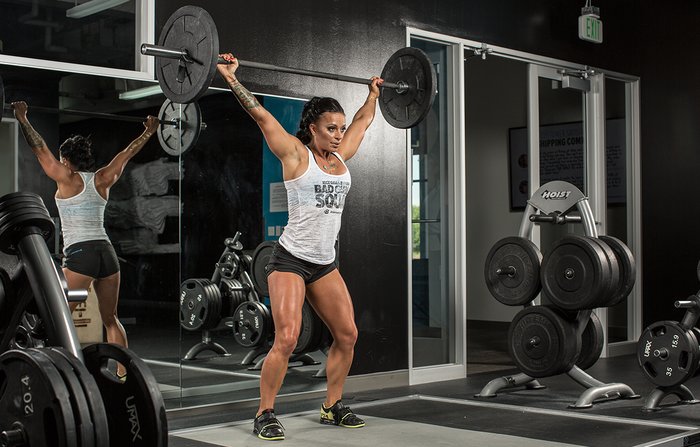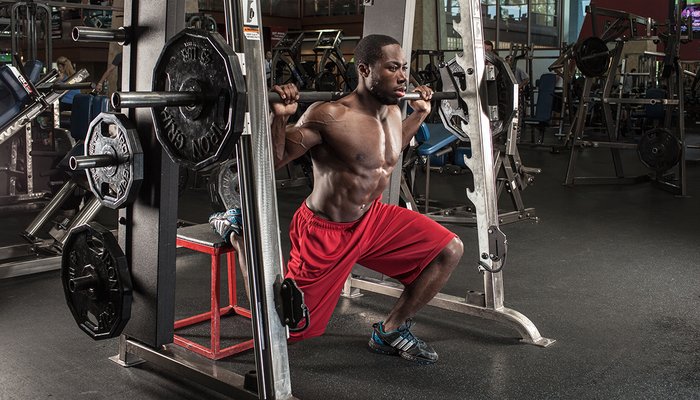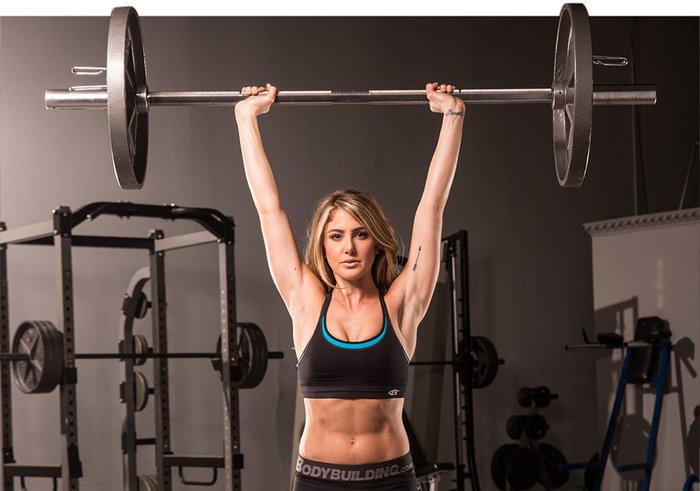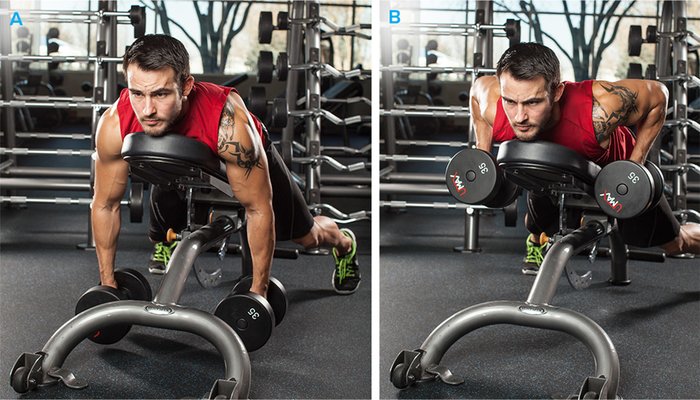- Squat (High And Low Bar)
- Front Squat
- Olympic Lifts: Snatch And Power Clean
- Deadlift
- Bulgarian Split Squat
Why it's on the list: Squats are king because they're simply the most challenging leg movement you can do, especially when loaded appropriately. They work all the lower-body musculature (we're counting glutes), and have been shown to spike muscle-building hormone release. In fact, we even know that squatting before doing curls has been shown to significantly improve arm strength!
We've grouped the high bar squat and low bar squat here, although they're a bit different. Bodybuilders typically use the high bar squat, in which the bar rests atop the traps, which hits all the leg musculature fairly evenly. Powerlifters prefer the low version, in which the bar instead sits further down atop the rear delts, since this variation slightly shifts the body's center of gravity such that the glutes take up more of the workload, which immediately allows the lifter to use more weight.

Biomechanically, these two versions are completely different animals. With the high bar squat, the torso stays more vertical and increases the knee movement away from the center of gravity. This places a greater load on the quads. The low bar squat has a greater torso lean and increases the hip movement away from the center of gravity, thus placing a greater stress on the glutes.
In all variations, the depth of squat is determined by your ability to maintain a neutral spine, as well as tightness in your hip flexors and tightness in your calves. If you round your back before reaching 90 degrees in your hips, stop at that point and reverse direction. Rounding your lower back can injure the discs, especially if you're using a heavy weight!
You're not restricted to one type or the other, so feel free to use either movement in your workout, though you wouldn't typically include both on the same training day.
In your workout: Do this movement first with several light warm-up sets, pyramiding up in weight, before attempting your heaviest weight for multiple sets. Doing squats later in your workout mean your quads will be prefatigued, so you'll definitely sacrifice some weight, and good form will be more difficult to maintain.
Why it's on the list:Some individuals find that squats build their butts well, but they really need help building their quads. If that's you, try front squats! By shifting the bar from the back to the front of the body, even just 6-8 inches, you change the relative amount of muscle loading that occurs. Front squats emphasize the quads over the glutes and hams, which means you'll sacrifice some of the load.
This movement generally requires some pretty serious upper-back and core strength to maintain a neutral spine and keep you from missing weights. Don't be surprised if adding these into your workout routine beefs up your back as well! Also, with a front squat, you naturally maintain a much more vertical position, which may decrease the risk of low-back injury.
In your workout:In your workout: This exercise should typically replace the squat in your workout; do it first, when your energy levels are highest. You can hold the bar in the front rack position (also referred to as a clean grip) or with arms crossed. Do multiple sets of 6-10 reps, favoring the lower end if you're looking to build strength.
Why it's on the list:Movements like snatches and power cleans take some serious dedication and technique to master, but they can be unrivaled when you are trying to improve jumping power or squat strength. In fact, one scientific study found a nearly 18-percent greater improvement in squat 1RM after following an Olympic-based program compared to a traditional powerlifting program.

In your workout:These exercises require absolute concentration on technique and body position. Choose one or the other; this should be your very first exercise of the day. Focus on getting a good triple extension (ankles, knees, and hips), almost as if you were jumping with the bar. Lee Boyce has an excellent article on the Olympic lifts that we highly recommend. Stick to reps of 2-3; sets can range from 3-8.
Why it's on the list:Deadlifts and deadlift variations like sumo are considered whole-body exercises, specifically for the posterior chain, which includes the hamstrings and glutes. But there is quad activation in this movement as well, mainly observed in the sumo deadlift.
In your workout:This gets tricky, as deadlifts are typically trained during a program that's built around the bench press one day, squat the next, and deadlift on the last. That doesn't neatly fit with a bodybuilder's leg day.
Furthermore, the deadlift is commonly trained as part of back day. If you're training it with legs, you probably won't be able to go too heavy—keep the reps moderate, and stop short of failure.
Why it's on the list:This one is deceptively difficult, partly because of balance and partly because you're training one side at a time. The Bulgarian split squat is essentially a split squat, but your rear leg is elevated, which forces the front leg to pick up more of the workload. Try it on a Smith machine if you find it difficult to balance the weight.

When done right, this movement is devastating to your quads. In fact, some EMG evidence suggests that 4 sets using your 10-rep max with Bulgarians aren't too different from back squats. The same study also found similar testosterone responses between Bulgarians and back squats! In your workout: You really can't use much weight on this movement, so push it toward the middle of your leg-training session. Do multiple sets of 8-12 reps per leg, and shoot for close to muscular failure on each set. If you really want to bring up the intensity, try bodyweight Bulgarians with blood flow restriction (BFR).
Best shoulders exercises
- Barbell Push Press
- Standing Military Press (Barbell Or Dumbbell)
- Dumbbell Incline Row
- Seated Overhead Dumbbell Press
- Seated Overhead Barbell Press
Why it's on the list:This press allows you to load up the most weight (or do more reps) above all other overhead pressing moves. It's considered a bit more of a whole-body movement for developing explosiveness, so you lose some of the isolation effect if you do this same movement seated.
With the barbell atop your upper chest, bend your knees slightly and explode upward on the balls of your feet while pressing the bar overhead. Your lower body, core, delts, triceps, and upper pecs are all involved.

This is considered more of a strength/power movement than a bodybuilding exercise, but building more strength here can help you load up more plates in any number of other lifts. Moreover, doing movements that engage a great deal of muscle mass boost muscle-building hormones better than movements that don't.
In your workout:Because this variation uses so many muscle groups, don't do it every workout. When you do use it, perform it first in your workout, after warming up well.
For bodybuilders, this isn't the exercise to do every shoulder training day, but it's a great choice for increasing strength and power during an offseason phase.
Why it's on the list:Why it made the list: This is essentially a push press without the extra bit of body English generated through your legs. That makes it a better isolation movement, but this movement still isn't considered an isolation exercise. In fact, it's a highly demanding multijoint overhead press that, because it's not seated, still allows for a bit of momentum as well as increased muscle activation compared to the seated version.
Keep the bar just off your upper chest, and press straight overhead, stopping just short of lockout. Maintain a slight bend in your knees to absorb subtle changes in your center of gravity and relieve some of the stress on your lower back. We included both the barbell and dumbbell here. Research has shown that dumbbells elicit a greater degree of EMG activation, but this usually comes at the expense of the amount of weight lifted.
Be sure to maintain a neutral hip position. Tipping your hips forward or sticking your butt back can wreak havoc with your lumbar spine. If you spend all of your time injured, you'll miss out on the gains!
In your workout: This is your multijoint overhead press in your workout, so it substitutes for any of the other presses on this list. After warming up well, choose a challenging weight, but not one so heavy that you break form. If your triceps are lagging, grab a pair of dumbbells rather than a barbell; they require less triceps activation.
Why it's on the list:What the heck is a multijoint rowing exercise doing in an article about shoulder exercises? Remember, rowing movements don't just work the "back"; they also involve the rear delts to a significant degree as well.
We didn't realize just how much until we saw research from a 2014 study out of the University of Wisconsin (La Crosse) that compared mostly shoulder exercises to see which had the greatest EMG activation on each of the three delt heads. Of note, this particular row scored just as high as a dumbbell lateral raise for middle-delt activation (and significantly better than dumbbell shoulder presses, cable lateral raises, and even barbell upright rows). For rear delts, that same row scored the same as the seated rear-delt raise in terms of activation but significantly higher than the other eight exercises, though none of them would be considered rear-delt moves.

Because the row appears to hit both those heads particularly well, it appears it would be a good addition to your shoulder workout. Because other types of rows weren't considered in the study, it's impossible to say whether they'd be equally as good, but there are surely a number of variations to this movement, including supported T-bar rows and standing (done bent-over) T-bar rows. To best mimic the movement done in the study, which used dumbbells, use a wide grip on the machine. In your workout:If you pair back and shoulders on the same training day, this would be a smart exercise to transition between the two body parts. If you include this move with your shoulder workout, do your overhead presses first. Try this before adding single-joint movements.
Why it's on the list: Switching out the barbell for dumbbells on overhead presses works each side independently, making the move more challenging and requiring more input from stabilizer muscles. Moreover, the range of motion is a bit longer as you press the weights together overhead. (We recommend you don't allow them to touch.)
Going from standing to a seated position further removes your lower body from the lift. Because your upper arms go straight out to your sides during the motion, the middle delts are heavily recruited, with far less stress on the anterior delts than when a barbell is in front of your head.
In your workout:Do it first in your shoulder session. You'll generally be able to go much heavier on the seated dumbbell press than the standing alternative because of the increased base of support. When going heavy, we recommend a seat back that allows you to press your spine into it for safety. Also, use a spotter to help you get the weights into the starting position and give you a spot (or even a forced rep or two) as you push toward failure.
Raising the weights into position can be harder than it looks. Beginners, try this: When prepping to hoist the dumbbells overhead, grab a weight in each hand, sit down, place the dumbbells on your thighs toward your knees, and quickly lift one knee toward your shoulder to hoist the weight. Repeat using the opposite knee.
Why it's on the list:Sitting not only makes it hard to use momentum, it also creates a nice base from which to push the weight. A barbell recruits a greater degree of triceps musculature than dumbbells can. If you've got sore shoulders, stick to keeping the bar in front of you.

When you lower the barbell to the front, notice how your upper arms no longer move directly out to your sides, an indication that the anterior delts are now picking up some of the workload. In fact, this is evident in muscle activation patterns, which demonstrate significantly greater anterior delt activation with a barbell over dumbbells. Some lifters lower the bar behind their head, which more directly stimulates the middle delts. We discourage this approach, which even many longtime lifters find painful.
In your workout: Do these first in your workout, and use challenging weights. Use a seat back for support on heavy sets.
Previous End